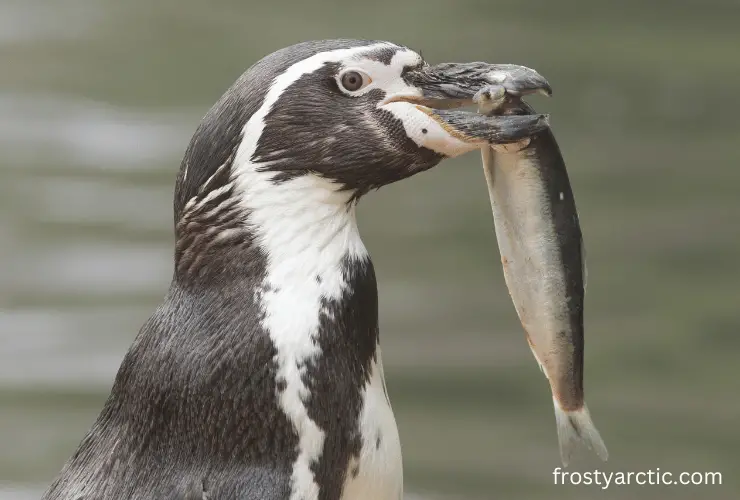No, penguins are carnivores and feed on fish, krill, squid, and other forms of sea life that they catch while swimming. They cannot eat plant material such as algae and other aquatic plants. Some species of penguins supplement their diet with cephalopods, a type of mollusk and squid.
These black and white birds also scavenge on occasion, eating carrion. However, their bodies are not adapted to eating plants; thus, they are purely carnivorous creatures.
This article investigates penguins’ diet and feeding behaviors. Did you know that penguins can digest these foods because they have a four-chambered stomach? Let’s learn more in this article!
Are Penguins Carnivores or Omnivores?
Penguins are predominantly carnivores, feeding primarily on krill, fish, squid, and other forms of sea life they catch while swimming underwater.
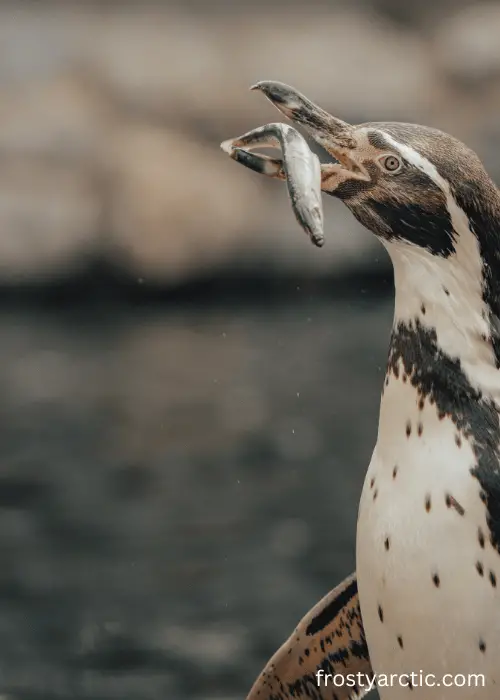
Food preferences for penguins vary across different species, which reduces competition among them.
Fun Fact: About 18 penguin species inhabit the Southern hemisphere, while the Galápagos penguin lives north of the Equator. ~ PBS.org
Penguins living in the Antarctic and the subantarctic tend to be slightly smaller and feed on krill and squid. The species further north eat fish.
For instance, Adelie penguins eat small krill, but chinstrap penguins prefer large krill. Emperor penguins and king penguins, on the other hand, survive on fish and squid.
Can Penguins Be Vegetarians?
In most cases, penguins cannot be vegetarians since they are carnivorous creatures. Plus, their bodies are not adapted to eating plant material.
Although penguins dive into the water, there is no scientific evidence that suggests they eat seaweed, algae, or any other form of plant material. In other words, they are not vegetarians.
Note: Penguins only eat other animals, including fish, krill, and squid, which is another piece of evidence that suggests they are not vegetarians.
Are King Penguins Omnivores?
No, king penguins are carnivores rather than omnivores. They have a varied diet that includes fish, squid, krill, and other crustaceans.
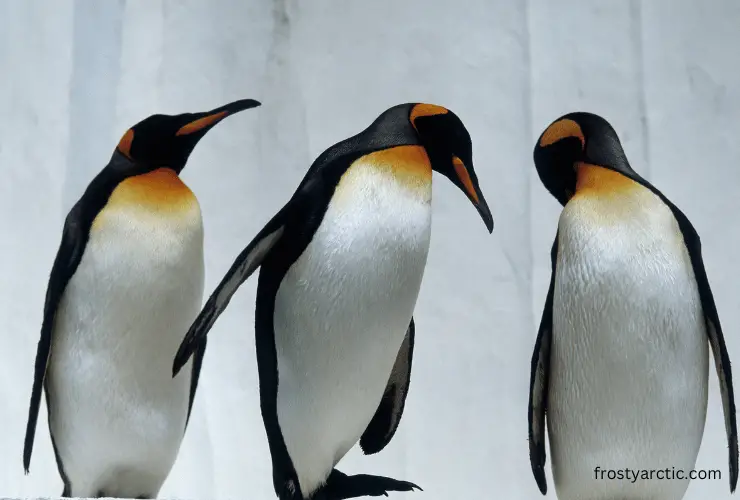
King penguins typically hunt in the water, diving to depths of up to 200 meters to find food.
Their diet consists primarily of lantern fish myctophids, with large amounts of squid consumed during the winter. The proportion of krill and other crustaceans in their diet is minimal.
Did you know? King penguins’ stomachs are adapted to drinking saltwater from the sea. Their stomach separates the salt from the water, ensuring they don’t get dehydrated. ~ Animalcorner.org
Is an African Penguin an Omnivore?
No, African Penguins are carnivores, as mentioned above. They are opportunistic feeders and eat a variety of prey items, including fish, squid, krill, and crustaceans.
These flightless birds feed primarily in the water, but they also consume food items on land. They typically catch prey by pursuit but may also wait in ambush and snatch prey as it passes by.
Fun Fact: African Penguins often feed in large groups to maximize their chances of finding food. ~ American Tarantula and Animals Organization
The diet of African penguins is highly varied and they take advantage of any food sources available.
They feed on a wide range of fish, including anchovies, sardines, herring, hake, and mackerel, as well as octopuses and crustaceans.
The diet of African penguins is highly influenced by the availability of food in their environment.
What Do Penguins Eat (Details About Their Diet)
Penguins are also opportunistic feeders and will eat a variety of other foods depending on availability.
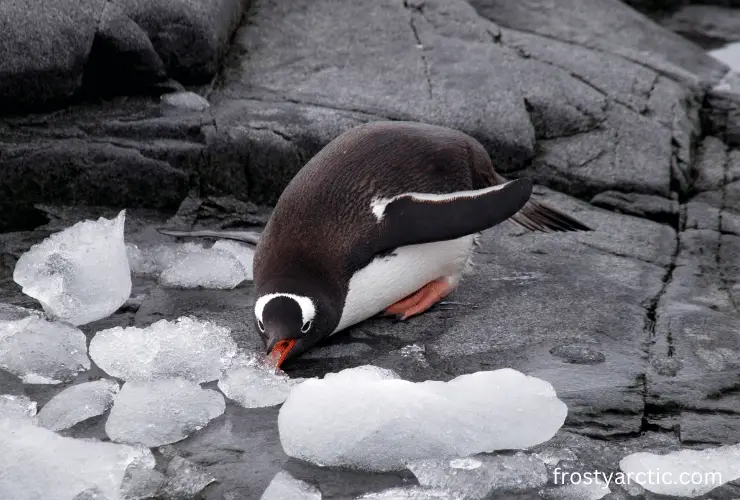
They are also known to eat small crustaceans such as copepods, amphipods, and isopods. Penguins living in different environments have been observed to feed on different prey items.
For example, penguins living in Antarctica may feed on silverfish, while those living on the Galápagos Islands may eat sardines and mackerel. Penguins living on the coasts of South Africa and Australia may feed on pilchards and anchovies.
Responsible for Being Carnivores
Penguins have several features and characteristics that make them well-adapted to their carnivorous diet.
They have sharp, pointed beaks that enable them to catch and hold onto their prey, as well as serrated edges on their bills that help them grip slippery fish.
Additionally, their streamlined bodies and powerful flippers allow them to swim rapidly and chase after prey, while their waterproof feathers help keep them warm and dry while diving for fish.
A Guide to Diet Analysis of Adélie Penguins (Pygoscelis adeliae)
Adelie penguins (Pygoscelis adeliae) are one of the most common species of penguins found in Antarctica.
Adelie penguins have been observed foraging for food in the water, sometimes traveling far from their breeding colonies. They have even been known to dive to depths of up to 150 meters in search of food.
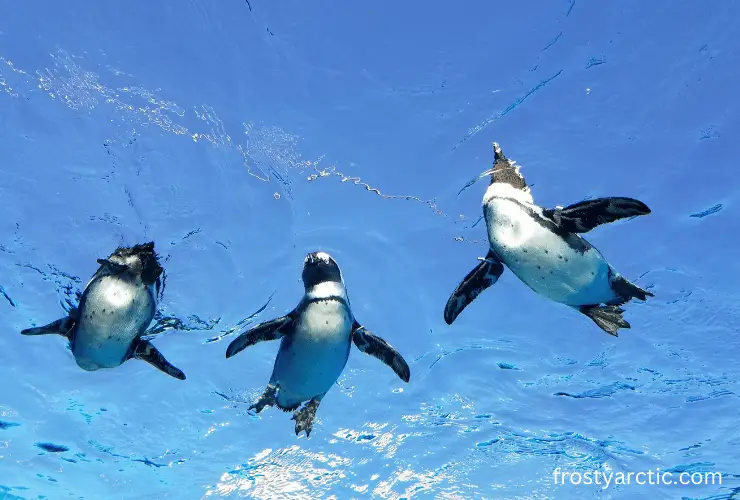
Krill is by far the most important component of their diet, comprising over 80% of the total food intake.
Research suggests that two krill species Euphausia superba and Euphausia crystallorophias, and notothenioid fish were among the most abundant components of the diet. Fish and squid make up the remaining 20%.
The diet of Adelie penguins can vary depending on the season and location, with dietary changes observed in different regions. For example, in some areas, fish may make up a greater proportion of the diet than in other areas.
These dietary changes are important for their survival, as they must adapt to changing conditions to ensure their survival.
Features and Characteristics
- Penguins are flightless seabirds:
These flightless seabirds have distinct appearances and behaviors. They are easily identified by their black and white feathers and their upright posture.
- Penguins use their wings to “fly” through the water:
Penguins use their wings to propel themselves with their webbed feet. This allows them to travel great distances and dive to depths of more than 600 feet.
- Penguins have several adaptations that help them survive in their cold:
These include a thick layer of blubber, strong claws for clinging to ice and feathers that are densely packed for insulation and waterproofing.
- Penguins are highly social birds:
Penguins live in large colonies and communicate with one another through a range of calls, from honks and gurgles to squawks and trills.
- Penguins are monogamous and mate for life:
They build nests to protect their eggs and take turns incubating them. The chicks are fed by both parents and remain with the family until they are ready to leave and start their own families.
Frequently Asked Questions (FAQs)
Do Penguins Eat Stones?
Yes, it has been observed that some penguin species, such as king, rockhopper, and macaroni penguins, swallow stones.
What Do Penguins Drink?
Penguins drink fresh water, typically obtained by consuming snow or licking ice. They may also get water from the foods they eat, such as fish and squid, which contain moisture. In some cases, penguins can even drink seawater in emergencies.
How Much Do Penguins Eat?
The amount of food penguins eat can vary depending on the species and the time of year. Some species, such as the Emperor penguin, can go without food for several months during the breeding season.

On the other hand, others, like the Adelie penguin, may eat up to 2 pounds of food per day during the summer months.
How Do Penguins Eat?
Penguins typically catch their prey underwater. They use their streamlined bodies and powerful flippers to swim rapidly and chase after fish and other marine creatures.
They use their sharp, pointed beaks and serrated edges on their bills to catch and hold onto their prey, which they swallow whole.
Are Penguins Mammals?
No, penguins are not mammals, although they share some physical characteristics with mammals, such as their thick layers of feathers and ability to regulate their body temperature. They are a type of flightless bird that belongs to the family Spheniscidae.
Conclusion
Penguins are fascinating birds with unique adaptations for their harsh Antarctic environment.
Their behavior, communication, and breeding strategies have been studied extensively, revealing new insights into their biology and ecology.
Ongoing research on the effects of climate change and human activities on penguin populations underscores the importance of conservation efforts to protect these iconic and vulnerable species.

